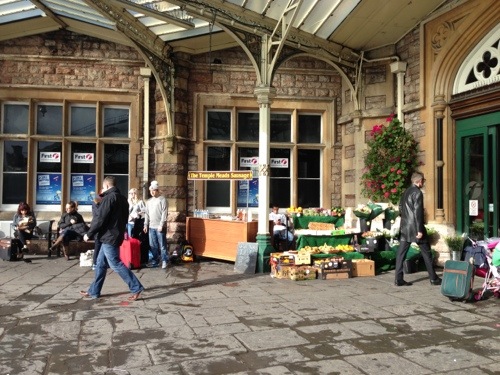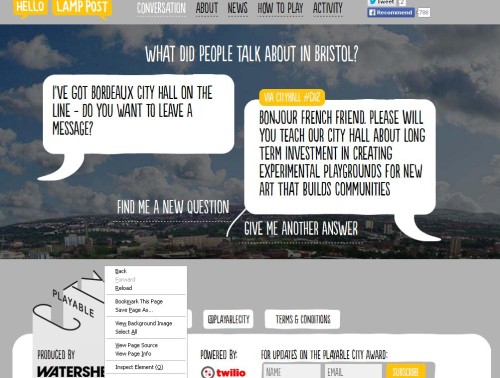Hello Lamppost – by Watershed in Bristol. The First Playable City Award
On a recent trip to Bristol I was struck by the way in which the city gave a sense of being joined-up, generous in signposting the wider cultural offer between cultural venues, bars, hotels and even on a street level. It would appear 30 years of hard graft and development was bearing fruit, as a visitor I was impressed that Bristol told a story of weaving a narrative of independence and pride. It helps that the physical signage (sandwich boards, official listings stuff, permanent public art, temporary installations) demonstrates a jostling together of both the grand and the esoteric. I met with Andrew Kelly of the Bristol Cultural Development Agency, who I’d been following as the instigator the Festival of Ideas and he gave me much food for thought with regards Legible Cities
What does Legible mean?
What about Leeds?
We’ve (or our editor Phil Kirby) been long considering Leeds and our relationship with it. This new lens made me question if we are capitalising upon some of our rich history, or our present creativity, in the public realm at least. And by public realm I mean on-line as well as the physical routes we take through the city. Do physical and the social join up? We have some great new way-finding Walk It signs which definitely help navigate the city online and off, yet they are one marker in the layers of a city telling its story. You could also argue that Blue Plaques and the Leeds Owl Trail offer other ways to navigate the city. There are rumoured apps in development too, so perhaps one might argue we’re perfectly legible already?
Can you experience a jumble of culture, history, independent bars and cafes in an environment that has a unique sense of place in Leeds?
Already there are physical signs of interdependence, with relationships being forged between independent booksellers, coffee shops, bars, brands and individuals who are forming collaborations, new products and even new ventures. I started to illustrate this with anecdotal evidence and this post expanded by 1000 words immediately and I was left with a foreboding that I’d missed many out. Feel free to suggest those you think are creating district and vibrant public experiences in Leeds in the comments below.
Do we appreciate how much Leeds is knitting together, sure there are some tight affiliations which align for value based reasons, and if you were to look at this with the question of ‘How does this reflect a distinct and vibrant culture’ for the visitor or the resident, they might be pleasantly surprised by the connections forming to be bigger than the sum of their parts. But how would you know this if you weren’t ‘in the know’? How does this extend beyond the wealthy city centre into the lesser loved localities as well as the up & coming? How do we understand the vitality and diversity of all our city?
Sociable City?
Phil Jewitt asked if Leeds were a sociable city and I’d say that yes we *nearly* are, with much interconnectedness. There are people who tirelessly spread the word about the great stuff that’s happening, ask questions, go to events, cheer lead and champion, every day without being asked or paid, and indeed some do a great job of it because they believe in it and actually it happens to be their role to do so too. But are we getting close to being a ‘Legible City’?
So how can blend online and offline storytelling?
What about co-sponsorsing advertising billboards in transport hubs which are owned by nobody but we agree on a city hashtag which asks visitors and residents to tell us what they’ve enjoyed on their visit to Leeds? There could be a monthly commission created to showcase local art and design on these posters, based on a theme, or event. (No reason why these can’t be applied to any town or city in all honesty). What if all venues included that hashtag on their billboards, posters and fliers with the same call to action? What if we used that same hashtag on our websites? What if we used it on Twitter/Instagram/Pinterest etc? What if that hashtag could be curated (a little) and the live tags be seen with picture/video content on Big and handheld screens across the city. What if we asked developers to sponsor their hoardings, cranes, security meshes, to facilitate creative distinct story telling about our city? What if the 10 aql #scifiwifi blue telephone boxes installed recently across Leeds could collect and disseminate these cultural stories? Bristol’s Hello Lamppost neatly blended online, mobile and physical objects in creating a cohesive experience across Bristol (and not just the city centre) for a set period of time.
Some might argue for less ‘noise’ more focus? The picking an historic theme which helps cohere past achievements, moments etc which tell us something of the present and help us think about the future & may help us to come together with more unity?
What or who are we waiting for to market our city?
I’m sure we’d find it tricky to agree a hashtag, and a method of curation, but surely it’s not that difficult? Don’t we all subscribe to the notion that the bigger picture, being connected and supporting each other, means that the job is made easier for those tasked with marketing the city to potential investors. We can add our own layers of independent story telling so that when big sporting and cultural events come to the city there add to the public experience and more importantly we’re not waiting for permission to market the city to ourselves and the rest of the world, and by taking the lead in showing we can do it together? There are currently early conversations about open cultural data percolating across the city right now so maybe this could be one such project?
Look beyond leaflet racks
Trinity Leeds and Leeds Arena are recent additions to the cultural landscape and it’s to their credit that both have worked hard to be part of the Leeds community and work with the independents in the city. My next request is that bigger venues who work so well with us and the bloggers who get amazing opportunities to have behind the scenes access also consider the physical space they occupy and look beyond the leaflet racks to promote the wider cultural offer. Both on line and off they could be signposting and using their clout to tell people about the stuff happening nearby and by employing an agreed independent hashtag help their audiences become aware of stuff happening across the city. They could also embed the Leeds Inspired API into their websites so that if a visitor looking for something to do doesn’t see something on that night, they could be aware of a host of other events across the city that day/night.
Eventually I’d like to see more explicit partnership working to create ‘signals of intent’ which feed their way into the design public seating & street furniture, playful interactive public art, creative spaces within new developments, public transport, visitor centres, the markets, traffic islands, shopping centres, shop windows, and mainstream media…Imagine if we had local produce at Leeds Train Station (see Bristol Sausages in the picture at the footer).
How do we work together to market the entire city so it represents the distinct and vibrant offer to both residents, investors and visitors?
I was inspired into actually writing this post when I considered this role at Leeds and Partners. My experience of sitting on a few sub groups, sector task forces & steering committees, has made me realise that if we want the city we want to see and dwell in, then surely it’s up to us to work together, to reach a critical mass, to have a voice collectively without any one leader having to hand one to us…
Is this a subject for Hyperlocal stuff? I’m one of the panelists for Nesta and the TSB as they launch the new £2.5million fund on Tuesday


Read this and remembered this cracking John Thorp presentation.
http://www.urbannous.org.uk/John-Thorpe-From-City-Centre-to-Region.htm
For a city to be understood as soon as one stepped foot in it, it would be good to measure the current dominant narratives of Best City and Child Friendly City in the experience.
So looking at ‘Best City’ at the moment you’d think it’s Best city for grey hard surfaces, cars and spending cash, a conversation about how a Best city would look and feel would be a start.
As in does a Best City encourage as much ‘dwell’ in order for the money to ‘flow’?
Does the Best City give voice or provide an equal platform to all it’s citizens or just those who are digitally enabled?
If the Best City is green and sustainable how would we know that (some nice planting from Incredible Edible, The Green Corridor, Wild Flower meadows, all well and good but HOW WOULD YOU KNOW, unless you were in that part of town’?
The Best City for young people, children and families? Apart from ‘promotional and recruitment banners’ how would you know? Any pocket playgrounds, much child designed seating and play areas? Are Walk It Signs aimed at child sized people? Do shops and restaurants demonstrate a welcome to young people across the city? If Best City is integenerational then we should be encouraging more areas for all ages to be in concert with each other, no matter what the weather. With seating that doesn’t act as a cattle prod. There should be encouraging signs that all toilets inside stores welcome people to use them in a cohesive signage scheme across the city. Welcome, use our loos!
Is economic prosperity the key indicator of a Best City? Cranes in the Sky, no empty units, money being spent in the town centre? What about the outer areas of Leeds? How would you know if they were part of the ‘Best city’ narrative? How can our transport systems be conduits to understanding the parts we never traverse to?
If we are a valued based city, then how do those values become lived and experienced in the hard and soft fabric of the city, in the way people behave, welcome each other, and pick up on visual clues as they take a stroll, ride, march, across the city? If we were to be truly social as a city wouldn’t we encourage more time to sit and have a chat together without spending money?
These are just my Monday morning ramblings about legibility, being felt rather than told…